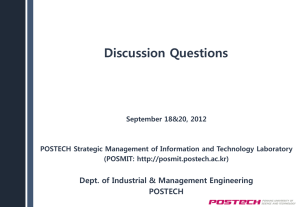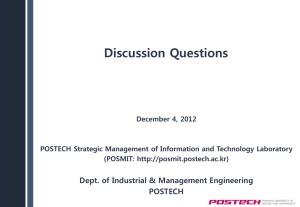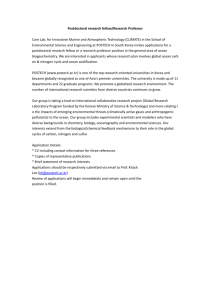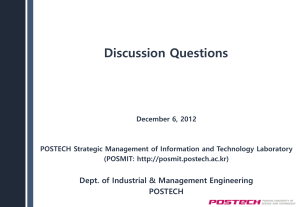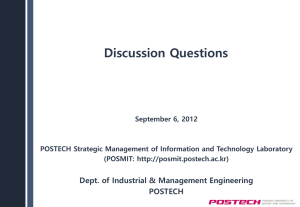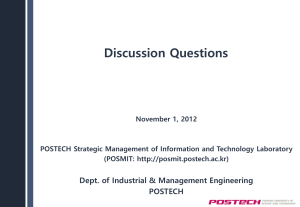FODA: Twenty Years of Perspective on Feature Models Kyo Chul Kang
advertisement
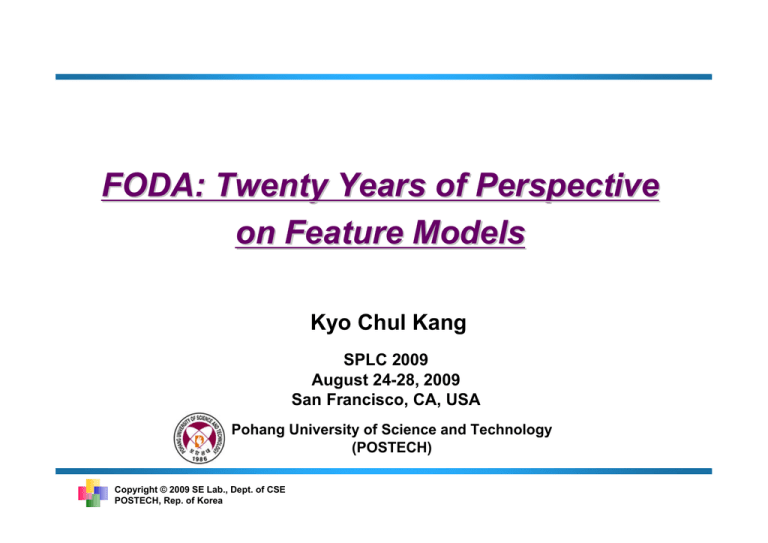
FODA: Twenty Years of Perspective on Feature Models Kyo Chul Kang SPLC 2009 August 24-28, 2009 San Francisco, CA, USA Pohang University of Science and Technology (POSTECH) Copyright © 2009 SE Lab., Dept. of CSE POSTECH, Rep. of Korea Prologue POSTECH Copyright © 2009 SE Lab., Dept. of CSE POSTECH, Rep. of Korea 2/<61> Prologue POSTECH Copyright © 2009 SE Lab., Dept. of CSE POSTECH, Rep. of Korea 3/<61> Prologue POSTECH Copyright © 2009 SE Lab., Dept. of CSE POSTECH, Rep. of Korea 4/<61> Prologue POSTECH Copyright © 2009 SE Lab., Dept. of CSE POSTECH, Rep. of Korea 5/<61> Prologue 1533 Citations! (August 12, 2009) POSTECH Copyright © 2009 SE Lab., Dept. of CSE POSTECH, Rep. of Korea 6/<61> Prologue We are talking about FODA POSTECH Copyright © 2009 SE Lab., Dept. of CSE POSTECH, Rep. of Korea 7/<61> Agenda ¾ Introduction ¾ Looking Back • Number of Citations • Feature Model Genealogy • Why Popular? • Salient Features of FODA Report ¾ Looking Forward • Future Works • Other Issues ¾ Acknowledgement POSTECH Copyright © 2009 SE Lab., Dept. of CSE POSTECH, Rep. of Korea 8/<61> Agenda ¾ Introduction ¾ Looking Back • Number of Citations • Feature Model Genealogy • Why Popular? • Salient Features of FODA Report ¾ Looking Forward • Future works • Other Issues ¾ Acknowledgement POSTECH Copyright © 2009 SE Lab., Dept. of CSE POSTECH, Rep. of Korea 9/<61> Introduction POSTECH Copyright © 2009 SE Lab., Dept. of CSE POSTECH, Rep. of Korea 10/<61> Introduction People James A. Hess William E. Novak Sholom G. Cohen A. Spencer Peterson Kyo C. Kang November 1990 August 2009 POSTECH Copyright © 2009 SE Lab., Dept. of CSE POSTECH, Rep. of Korea 11/<61> Agenda ¾ Introduction ¾ Looking Back • Number of Citations • Feature Model Genealogy • Why Popular? • Salient Features of FODA Report ¾ Looking Forward • Future Works • Other Issues ¾ Acknowledgement POSTECH Copyright © 2009 SE Lab., Dept. of CSE POSTECH, Rep. of Korea 12/<61> Prologue 1314 Citations! (June 06, 2009) POSTECH Copyright © 2009 SE Lab., Dept. of CSE POSTECH, Rep. of Korea 13/<61> Number of Citations 1990~2009 (June 6) Total: 1314 Unknown/Overlapping: 442 POSTECH Copyright © 2009 SE Lab., Dept. of CSE POSTECH, Rep. of Korea 14/<61> Number of Citations 1990~2008 (June 6) Total: 1280 Unknown/Overlapping: 442 POSTECH Copyright © 2009 SE Lab., Dept. of CSE POSTECH, Rep. of Korea 15/<61> Number of Citations Regional Differences 529 206 113 6 4 POSTECH Copyright © 2009 SE Lab., Dept. of CSE POSTECH, Rep. of Korea 1990~2009 (June 6) Total: 1314 Unknown/Overlapping: 456 16/<61> Number of Citations Industry vs. Academia 714 53 84 POSTECH Copyright © 2009 SE Lab., Dept. of CSE POSTECH, Rep. of Korea 1990~2009 (June 6) Total: 1314 Unknown/Overlapping: 467 17/<61> Source Differences Number of Citations 1990~2009 (June 6) Total: 1314 Unknown/Overlapping: 425 Not-English: 81 POSTECH Copyright © 2009 SE Lab., Dept. of CSE POSTECH, Rep. of Korea 18/<61> Top Conferences Number of Citations SPLC: International Software Product Line Conference ICSE: International Conference on Software Engineering ICSR/WISR: International Conference on Software Reuse/ Annual Workshops on Institutionalizing Software Reuse OOPSLA: International Conference on Object Oriented Programming, Systems, Languages and Applications ECOOP: European Conference on Object-Oriented Programming GPCE: International Conference on Generative Programming and Component Engineering VaMoS: International Workshop on Variability Modeling of Software-intensive Systems RE: International Requirements Engineering Conference APSEC: Asia-Pacific Software Engineering Conference CAiSE: International Conference on Advanced Information Systems Engineering AOSD: International Conference on Aspect-Oriented Software Development POSTECH Copyright © 2009 SE Lab., Dept. of CSE POSTECH, Rep. of Korea 19/<61> Conference Trend Number of Citations POSTECH Copyright © 2009 SE Lab., Dept. of CSE POSTECH, Rep. of Korea 20/<61> Number of Citations Subject Differences ¾ Subject Categories • • • • • • • • Feature Modeling Feature Model Formalization Feature Model Extension Generative Programming Domain-Specific Language Feature-Oriented Design/Programming Product Configuration Variability Management • • Product Line Methodology /Product Line Adoption Doman Analysis /Requirements Analysis Domain-Specific Architecture Reusable Component Development Refactoring/Reengineering • Tool Development • • • Business Application Embedded Application SOA • Other • • • POSTECH Copyright © 2009 SE Lab., Dept. of CSE POSTECH, Rep. of Korea 21/<61> Subject Differences Number of Citations 1990~2009 (June 6) Total: 1314 Unknown/Overlapping: 450 Not-English: 56 Others: 51 POSTECH Copyright © 2009 SE Lab., Dept. of CSE POSTECH, Rep. of Korea 22/<61> Subject Trend Number of Citations POSTECH Copyright © 2009 SE Lab., Dept. of CSE POSTECH, Rep. of Korea 23/<61> Top-30 People Number of Citations 1990~2009 (June 6) Total: 1314 Unknown/Overlapping: 415 POSTECH Copyright © 2009 SE Lab., Dept. of CSE POSTECH, Rep. of Korea 24/<61> Survey: Top-30 People Survey 1. What are the contributions of FODA? 2. What are the remaining problems for FODA? 3. What is your own one-sentence definition/feeling about the feature model? 4. Anything else you would suggest for inclusion? POSTECH Copyright © 2009 SE Lab., Dept. of CSE POSTECH, Rep. of Korea 25/<61> Survey The Contributions of FODA: Systematic domain analysis method used in software product line engineering. (C Kastner, S Apel, C Lengauer) Strongly influencing how software configuration is seen in software product line, and popularizing the domain analysis concept. (K Schmid) Laying the groundwork for feature analysis and feature modeling. (J Van Gurp) Feature modeling : Essential technique for defining the space of programs that define a software product line. (D Batory) Simple but comprehensive way to modeling commonalities and variabilities in a domain. (H Zhang, J Lee, S Jarzabek, T Asikainen) Easy to use and communicate between stakeholders. (C Kastner) Giving a name to a fundamental form of modularity in context of product lines. (D Batory) POSTECH Copyright © 2009 SE Lab., Dept. of CSE POSTECH, Rep. of Korea 26/<61> Survey The Remaining Problems for FODA: Addressing other parts of the life cycle (Especially application engineering). (K Schmid) Clear mapping between features and software artifacts. (J Van Gurp, K Schmid) Standardization of feature model extensions; Trade-off between expressiveness and simplicity. (C Kastner, S Apel, C Lengauer, T Asikainen, K Schmid) Scalability of feature model. (C Kastner, D Batory) Managing Complexity in view of many inter-dependent features. (J Van Gurp, S Jarzabek) Feature model evaluation. (J Lee) Integration with UML Model. (S Jarzabek) Good teaching materials. (D Batory) POSTECH Copyright © 2009 SE Lab., Dept. of CSE POSTECH, Rep. of Korea 27/<61> Survey Own One-Sentence Definition/Feeling about the Feature Model: A model that provides the foundations of software reuse. (J Lee) A simple means to describe the commonalities and variabilities of a domain / product line. (S Apel, C Lengauer) Good and easy to understand, practical and fundamental. (H Zhang) Easy to use (management-compatible) graphical model to describe variability. (C Kastner) Great notation, accepted by all in the field. (S Jarzabek) One of the useful ways to analyze requirements (required features) as well as a means to describe given software in terms of features (provided features). (J Van Gurp) An idea well received by the community but still lacking content meeting the scientific standards. (T Asikainen) Great approach to make one understand the core idea of product line engineering (But I’m not sure whether it is the right way of looking at variability for the actual development). (K Schmid) POSTECH Copyright © 2009 SE Lab., Dept. of CSE POSTECH, Rep. of Korea 28/<61> Feature Model Genealogy Original Feature Model (FODA) (KC Kang et al., 1990) FORM Feature Model (KC Kang et al., 1998) FeatuRSEB Feature Model (ML Griss et al., 1998) Hein et al. Model (A Hein et al., 2000) Van Gurp et al. Feature Model (J van Gurp et al., 2001) Riebisch et al. Feature Model (M Riebisch et al., 2002) Generative Programming (GP) Feature Model (K Czarnecki et al., 2000) GP-Extended Feature Model (K Czarnecki et al., 2002) Cardinality-Based Feature Model (K Czarnecki et al., 2004) PLUSS Feature Model (M Eriksson et al., 2005) POSTECH Copyright © 2009 SE Lab., Dept. of CSE POSTECH, Rep. of Korea Benavides et al. Feature Model (D Benavides et al., 2005) 29/<61> Feature Model Genealogy Original Feature Model (KC Kang et al., 1990) FORM Feature Model (KC Kang et al., 1998) FeatuRSEB Feature Model (ML Griss et al., 1998) Hein et al. Model (A Hein et al., 2000) Van Gurp et al. Feature Model (J van Gurp et al., 2001) Riebisch et al. Feature Model (M Riebisch et al., 2002) Generative Programming (GP) Feature Model (K Czarnecki et al., 2000) GP-Extended Feature Model (K Czarnecki et al., 2002) Cardinality-Based Feature Model (K Czarnecki et al., 2004) PLUSS Feature Model (M Eriksson et al., 2005) POSTECH Copyright © 2009 SE Lab., Dept. of CSE POSTECH, Rep. of Korea Benavides et al. Feature Model (D Benavides et al., 2005) 30/<61> Feature Model Genealogy Original Feature Model (KC Kang et al., 1990) Feature diagram: A Graphical And/Or Hierarchy of Features - Mandatory / Optional / Alternative Feature - Composed-of Relationship Composition Rules: Mutual Dependency (Requires) and Mutual Exclusion (Mutex-with) Relationships Issues and Decisions: Record of Trade-offs, Rationales, and Justifications System Feature Catalogue: Record of Existing System Features POSTECH Copyright © 2009 SE Lab., Dept. of CSE POSTECH, Rep. of Korea 31/<61> Feature Model Genealogy ¾ Extensions from Original Feature Model • Diagram Shape • Layer • Relationship Type • Feature Type • Feature Attribute • Feature Cardinality • Feature Group and Group Cardinality • Constraint Notation • Binding Time Notation POSTECH Copyright © 2009 SE Lab., Dept. of CSE POSTECH, Rep. of Korea 32/<61> Feature Model Genealogy Original Feature Model (KC Kang et al., 1990) FORM Feature Model (KC Kang et al., 1998) FeatuRSEB Feature Model (ML Griss et al., 1998) Hein et al. Model (A Hein et al., 2000) Van Gurp et al. Feature Model (J van Gurp et al., 2001) Riebisch et al. Feature Model (M Riebisch et al., 2002) Generative Programming (GP) Feature Model (K Czarnecki et al., 2000) GP-Extended Feature Model (K Czarnecki et al., 2002) Cardinality-Based Feature Model (K Czarnecki et al., 2004) PLUSS Feature Model (M Eriksson et al., 2005) POSTECH Copyright © 2009 SE Lab., Dept. of CSE POSTECH, Rep. of Korea Benavides et al. Feature Model (D Benavides et al., 2005) 33/<61> Feature Model Genealogy FORM Feature Model (KC Kang et al., 1998) Layer - Capability - Operating Environment - Domain Technology - Implementation Technology Relationship Type: - Implemented-by POSTECH Copyright © 2009 SE Lab., Dept. of CSE POSTECH, Rep. of Korea 34/<61> Feature Model Genealogy Original Feature Model (KC Kang et al., 1990) FORM Feature Model (KC Kang et al., 1998) FeatuRSEB Feature Model (ML Griss et al., 1998) Hein et al. Model (A Hein et al., 2000) Van Gurp et al. Feature Model (J van Gurp et al., 2001) Riebisch et al. Feature Model (M Riebisch et al., 2002) Generative Programming (GP) Feature Model (K Czarnecki et al., 2000) GP-Extended Feature Model (K Czarnecki et al., 2002) Cardinality-Based Feature Model (K Czarnecki et al., 2004) PLUSS Feature Model (M Eriksson et al., 2005) POSTECH Copyright © 2009 SE Lab., Dept. of CSE POSTECH, Rep. of Korea Benavides et al. Feature Model (D Benavides et al., 2005) 35/<61> Feature Model Genealogy FeatuRSEB Feature Model (ML Griss et al., 1998) Combine FODA and the Reuse-Driven Software Engineering Business (RSEB) Feature Type - Alternative Feature → Variation Point Feature / Variant Feature Constraint Notation (with Dashed Arrow) Bound Time Notation - Reuse Time Bound (XOReddisjunction) - Use Time Bound (ORed-disjunction) POSTECH Copyright © 2009 SE Lab., Dept. of CSE POSTECH, Rep. of Korea 36/<61> Feature Model Genealogy Van Gurp et al. Feature Model (J van Gurp et al., 2001) Feature Type - External Feature - Alternative Feature → OR Specialization/ XOR Specialization Binding Time Notation POSTECH Copyright © 2009 SE Lab., Dept. of CSE POSTECH, Rep. of Korea 37/<61> Feature Model Genealogy PLUSS Feature Model (M Eriksson et al., 2005) Diagram Shape - Feature as Circle (Black, White, ‘S’, ‘M’) Feature Type - Alternative Feature → Single Adapter / Multiple Adapter Constraint Notation POSTECH Copyright © 2009 SE Lab., Dept. of CSE POSTECH, Rep. of Korea 38/<61> Feature Model Genealogy Original Feature Model (KC Kang et al., 1990) FORM Feature Model (KC Kang et al., 1998) FeatuRSEB Feature Model (ML Griss et al., 1998) Hein et al. Model (A Hein et al., 2000) Van Gurp et al. Feature Model (J van Gurp et al., 2001) Riebisch et al. Feature Model (M Riebisch et al., 2002) Generative Programming (GP) Feature Model (K Czarnecki et al., 2000) GP-Extended Feature Model (K Czarnecki et al., 2002) Cardinality-Based Feature Model (K Czarnecki et al., 2004) PLUSS Feature Model (M Eriksson et al., 2005) POSTECH Copyright © 2009 SE Lab., Dept. of CSE POSTECH, Rep. of Korea Benavides et al. Feature Model (D Benavides et al., 2005) 39/<61> Feature Model Genealogy Hein et al. Feature Model (A Hein et al., 2000) Use of UML Relationship Type - Arrow for Secondary Structure <<alternative>> 0..* UML Feature Meta Model <<alternative>> [mutex] 2..* <<simple>> <<mandatory feature>> <<compound>> 2..* 0..* [mutex] [mutex] <<alternative>> <<consists of>> 0..* <<optional alternative>> 1..* “f6” is “Optional Compound” in Primary Structure and “Alternative” in Secondary Structure <<mutex>> * <<role>> <<appears>> <<feature>> -bind-time : (compile, load, run) -decomp-type : String 1..* [mutex] * <<requires>> <<consists of>> 0..* <<optional simple>> <<optional feature>> <<optional compound>> POSTECH Copyright © 2009 SE Lab., Dept. of CSE POSTECH, Rep. of Korea 40/<61> Feature Model Genealogy Original Feature Model (KC Kang et al., 1990) FORM Feature Model (KC Kang et al., 1998) FeatuRSEB Feature Model (ML Griss et al., 1998) Hein et al. Model (A Hein et al., 2000) Van Gurp et al. Feature Model (J van Gurp et al., 2001) Riebisch et al. Feature Model (M Riebisch et al., 2002) Generative Programming (GP) Feature Model (K Czarnecki et al., 2000) GP-Extended Feature Model (K Czarnecki et al., 2002) Cardinality-Based Feature Model (K Czarnecki et al., 2004) PLUSS Feature Model (M Eriksson et al., 2005) POSTECH Copyright © 2009 SE Lab., Dept. of CSE POSTECH, Rep. of Korea Benavides et al. Feature Model (D Benavides et al., 2005) 41/<61> Feature Model Genealogy Generative Programming Feature Model (K Czarnecki et al., 2000) Diagram Shape - Feature Name in a Box - Box with Circle : Black = Mandatory : White = Optional Feature Type - OR Feature (Black Triangle) POSTECH Copyright © 2009 SE Lab., Dept. of CSE POSTECH, Rep. of Korea 42/<61> Feature Model Genealogy Riebisch et al. Feature Model (M Riebisch et al., 2002) Diagram Shape / Feature Type - Inherit GP Feature Model Feature Group and Group Cardinality Constraint Notation GP Extended Feature Model (K Czarnecki et al., 2002) Diagram Shape / Feature Type - Inherit GP Feature Model Feature Attributes Feature Cardinality POSTECH Copyright © 2009 SE Lab., Dept. of CSE POSTECH, Rep. of Korea 43/<61> Feature Model Genealogy Cardinality-Based Feature Model (K Czarnecki et al., 2004) Diagram Shape / Feature Type - Inherit GP Feature Model Relationship Type - Feature Diagram Reference (Dashed Line) Feature Cardinality Feature Group and Group Cardinality POSTECH Copyright © 2009 SE Lab., Dept. of CSE POSTECH, Rep. of Korea 44/<61> Feature Model Genealogy Original Feature Model (KC Kang et al., 1990) FORM Feature Model (KC Kang et al., 1998) FeatuRSEB Feature Model (ML Griss et al., 1998) Hein et al. Model (A Hein et al., 2000) Van Gurp et al. Feature Model (J van Gurp et al., 2001) Riebisch et al. Feature Model (M Riebisch et al., 2002) Generative Programming (GP) Feature Model (K Czarnecki et al., 2000) GP-Extended Feature Model (K Czarnecki et al., 2002) Cardinality-Based Feature Model (K Czarnecki et al., 2004) PLUSS Feature Model (M Eriksson et al., 2005) POSTECH Copyright © 2009 SE Lab., Dept. of CSE POSTECH, Rep. of Korea Benavides et al. Feature Model (D Benavides et al., 2005) 45/<61> Feature Model Genealogy Benavides et al. Feature Model (D Benavides et al., 2005) Diagram Shape / Feature Type - Inherit GP Feature Model Relationship Type - Attribute Relationship (with Dashed Line) Feature Attribute POSTECH Copyright © 2009 SE Lab., Dept. of CSE POSTECH, Rep. of Korea 46/<61> Why Popular? ¾ Codification of the Most Critical Information for Reuse • Commonality and Variability • Medium for Identifying Variation Points and Variants ¾ Simplicity ¾ Understandability • Intuitive ¾ Practicality ¾ Applicability POSTECH Copyright © 2009 SE Lab., Dept. of CSE POSTECH, Rep. of Korea 47/<61> Salient Features of FODA Report ¾ “ For example, features from the window manager domain such as constrainedMove and zapEffect could have been specified more precisely using a formal specification technique.” → Formalization ¾ “ If the domain is well-defined and is expected to remain stable, a preprocessor or an application generator development technique might be appropriate to process the compile-time features.” → Generative Programming ¾ “ The description should also indicate whether it is a compiletime, an activation-time, or a runtime feature.” → Binding time, Dynamic Product Line POSTECH Copyright © 2009 SE Lab., Dept. of CSE POSTECH, Rep. of Korea 48/<61> Salient Features of FODA Report ¾ “ The classification of the features can be used in the components construction for modularization and for selection of appropriate development techniques.” → Component Development ¾ “ A record of the issues and decisions that arise in the course of the feature analysis must be incorporated into the feature model to provide the rationale for choosing options and selecting among several alternatives.” → Configuration Decision Support POSTECH Copyright © 2009 SE Lab., Dept. of CSE POSTECH, Rep. of Korea 49/<61> Agenda ¾ Introduction ¾ Looking Back • Number of Citations • Feature Model Genealogy • Why Popular? • Salient Features of FODA Report ¾ Looking Forward • Future Works • Other Issues ¾ Acknowledgement POSTECH Copyright © 2009 SE Lab., Dept. of CSE POSTECH, Rep. of Korea 50/<61> Future Works Feature Modeling and Analysis Feature analysis for different aspects at different phases of the life-cycle PL Contexts Requirements Design Implementation Legal / Social Constraint Domain model Architecture Modules / Algorithms User Profile Capability Component Market / Business Use Case Variation Point / Variants Configuration View FM‐VP Decision Dependency Analysis (Consistency) Usage Operating Environment Structural View Computing Resource / Platform Dependency View Standards Binding View Platform Conformance Analysis Variation Support Analysis QA Conformance Analysis View Consistency Analysis Binding Time Support Connector Support Decision Modeling (Rationales), Variability/Integrity Management POSTECH Copyright © 2009 SE Lab., Dept. of CSE POSTECH, Rep. of Korea 51/<61> Other Issues Technology ¾ Domain analysis • Different domains may require different approaches − − − • Service analysis may be good for business applications domains How about goal analysis? “Goal -> Service->feature” as a unified method? Modeling mechanisms − Feature model is popular but many extensions › − • • Formalization Deciding the right level of abstraction; how to structure Feature explosion problem − − • Should it be standardized? How to model, analyze, and manage High level of complex dependencies among them Feature interaction problem POSTECH Copyright © 2009 SE Lab., Dept. of CSE POSTECH, Rep. of Korea 52/<61> Other Issues Technology ¾ Goal-oriented (value-based) configuration of features • • ¾ Knowledge-based configuration Quality attributes or user-goals Going from domain analysis to architecture and component design • Designing architectures and components based on the analysis results (commonality and variability information) − • • • SOA vs. agent-based vs. other architecture models Building variability into architectures and components Selecting appropriate mechanisms for the problem Dealing with complex dependencies between features POSTECH Copyright © 2009 SE Lab., Dept. of CSE POSTECH, Rep. of Korea 53/<61> Technology ¾ Other Issues Specification of models • ¾ Reuse contexts and assumptions Verification of quality attributes of integrated systems • • ¾ Safety, reliability, etc. Detecting feature interaction problems Configuration management • • Version control of components and architectures with multiproduct nature Evolution of the product line itself POSTECH Copyright © 2009 SE Lab., Dept. of CSE POSTECH, Rep. of Korea 54/<61> Other Issues Technology ¾ PL for systems in the newly emerging computing environments • Service Oriented Architecture • Ubiquitous computing environment/cloud computing − − • From compile-time engineering to run-time engineering − ¾ Dynamic binding of features Run-time verification Embedment of SE knowledge in running systems Tools! POSTECH Copyright © 2009 SE Lab., Dept. of CSE POSTECH, Rep. of Korea 55/<61> Other Issues Process ¾ How to change to PL-based organization • • How to evolve: staged process model for reuse adoption Key process areas − • Metrics − − − ¾ Best practices Key indicators: cost of production, time-to-market, project completion time, etc. Relationship between reuse, quality, and productivity Relationship between reuse and ROI for sustainability of a reuse program Process models • Proactive vs. reactive vs. extractive models − • Best practices PL process vs. agile methods POSTECH Copyright © 2009 SE Lab., Dept. of CSE POSTECH, Rep. of Korea 56/<61> Management ¾ Other Issues Asset management (How to make PL-based development happen in an organization)-”Institutionalize” PL • • • • • Who should develop assets (with variation points) Who should maintain assets (variability management) Who will be responsible for quality assurance Who should enforce the use of assets (policies) Models (best practices) − ¾ Centralized vs. distributed Product line engineering in the context of a business strategy • “High option potentials” • ROI analysis − Estimating ROI from a reuse program − Estimating benefits from strategic market position Product line engineering in the global development environment ¾ • Component development outsourcing − − Variability specification Variability management POSTECH Copyright © 2009 SE Lab., Dept. of CSE POSTECH, Rep. of Korea 57/<61> Embedment of SE Knowledge Other Issues Technical Trends Automatic Manual Ad-Hoc Approach Incidental Application of Engineering Principles Modulization Information hiding Encapsulation … Systematic Approach Methods and Tools Commonality and variability analysis Parameterization Template framework … Context-aware Self-adaptive Software Embedment of Software Engineering Knowledge in the System Monitor and dynamic reconfigurator Dynamic binding Architecture reconfiguration Run-time verification … POSTECH Copyright © 2009 SE Lab., Dept. of CSE POSTECH, Rep. of Korea 58/<61> Agenda ¾ Introduction ¾ Looking Back • Number of Citations • Feature Model Genealogy • Why Popular? • Salient Features of FODA Report ¾ Looking Forward • Future Works • Other Issues ¾ Acknowledgement POSTECH Copyright © 2009 SE Lab., Dept. of CSE POSTECH, Rep. of Korea 59/<61> Acknowledgement Special thanks to my students: Hyesun Lee Hyunsik Choi Daesik Ham Yoonho Cho Yeonho Kim for data analysis! POSTECH Copyright © 2009 SE Lab., Dept. of CSE POSTECH, Rep. of Korea 60/<61> The End POSTECH Copyright © 2009 SE Lab., Dept. of CSE POSTECH, Rep. of Korea 61/<61>
